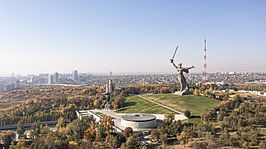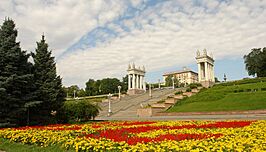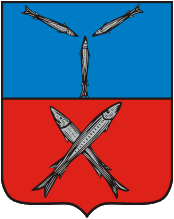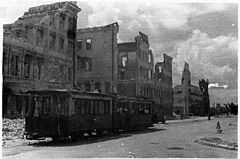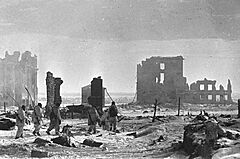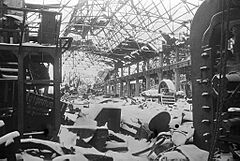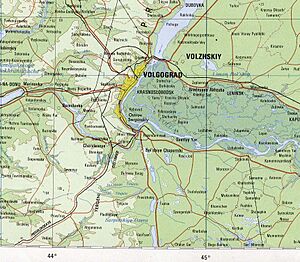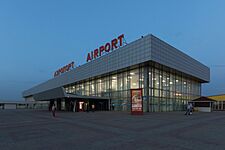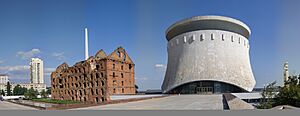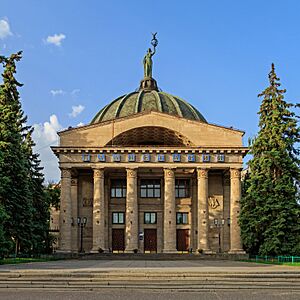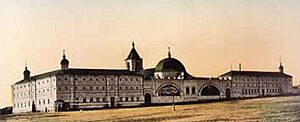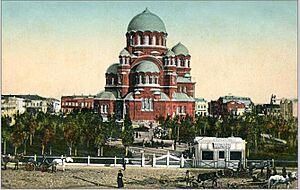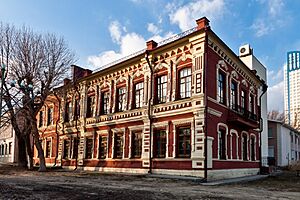Volgograd facts for kids
Quick facts for kids Volgograd (English)Волгоград (Russian) |
|
|---|---|
| - City - | |
| [[File:
|250px]] Top-down, left-to-right: The Motherland Calls on Mamayev Kurgan, the railway station, Eternal flame, The Metrotram, Gerhardt's Mill, Central embankment |
|
|
|
|
| City Day | Second Sunday of September |
| Administrative status | |
| Country | Russia |
| Federal subject | Volgograd Oblast |
| Administratively subordinated to | city of oblast significance of Volgograd |
| Municipal status | |
| Urban okrug | Volgograd Urban Okrug |
| Head | Vladimir Marchenko |
| Representative body | City Duma |
| Statistics | |
| Area | 859.35 km2 (331.80 sq mi) |
| Population (2010 Census, preliminary) |
1,021,215 inhabitants |
| - Rank in 2010 | 12th |
| Density | 1,188/km2 (3,077/sq mi) |
| Time zone | MSK (UTC+04:00) |
| Founded | 1589 |
| City status since | 1780 |
| Postal code(s) | 400000–400002, 400005–400012, 400015–400017, 400019–400023, 400026, 400029, 400031–400034, 400036, 400038–400040, 400042, 400046, 400048–400055, 400057–400059, 400062–400067, 400069, 400071–400076, 400078–400082, 400084, 400086–400089, 400093, 400094, 400096–400098, 400105, 400107, 400108, 400110–400112, 400117, 400119–400125, 400127, 400131, 400136–400138, 400700, 400880, 400890, 400899, 400921–400942, 400960–400965, 400967, 400970–400979, 400990–400993 |
| Dialing code(s) | +7 8442 |
| Official website: http://www.volgadmin.ru | |
Volgograd (Russian: Волгоград), a large city in Russia, is the main city of Volgograd Oblast. It sits on the western bank of the Volga River. The city covers about 859 square kilometers and has over one million people. Volgograd is the 16th largest city in Russia by population. It is also the second largest city in the Southern Federal District.
The city was first built as a fortress called Tsaritsyn in 1589. By the 1800s, Tsaritsyn became an important river port and trading hub. This made its population grow very quickly. In 1925, the city was renamed Stalingrad to honor Joseph Stalin, who was the leader of the country.
During World War II, the city faced a huge attack from Axis forces. This led to the Battle of Stalingrad, one of the biggest and bloodiest battles in history. Because of its brave fight, the city was given the title of Hero City. In 1961, the city's name was changed again to Volgograd. This was part of a plan to remove Stalin's name from places.
Today, Volgograd is home to The Motherland Calls, a huge statue dedicated to the heroes of the Battle of Stalingrad. This statue is 85 meters tall. It is the tallest statue in Europe. Volgograd also has many other interesting places to visit. These include museums, sandy beaches, and even a unique floating church. The city was also one of the host cities for the 2018 FIFA World Cup.
Contents
- Understanding Volgograd's Names
- Exploring Volgograd's Past
- How Volgograd is Governed
- Volgograd's Economy
- Getting Around Volgograd
- Volgograd's People
- Culture and Landmarks
- Religion in Volgograd
- Learning in Volgograd
- Sports in Volgograd
- Famous People from Volgograd
- Volgograd's Sister Cities
- Volgograd's Climate
- Images for kids
- See also
Understanding Volgograd's Names
Volgograd has had a few different names over time. Each name tells a part of its history.
Why it was called Tsaritsyn
The city was first founded in 1589. It was named Tsaritsyn after the nearby Tsaritsa River. The name was spelled Царицынъ in old Russian.
How it became Stalingrad
After Vladimir Lenin died in 1924, Joseph Stalin became the country's leader. In 1925, Tsaritsyn was renamed Stalingrad. This was to honor Stalin's role in defending the city during the Russian Civil War. The name Stalingrad combines Stalin's name with "grad," which means "settlement" or "city" in Russian.
The change to Volgograd
After Stalin's death, Nikita Khrushchev started a policy called De-Stalinization. This meant removing Stalin's name from places and policies. So, in 1961, the city's name was changed to Volgograd. This new name comes from the Volga River, which flows next to the city.
Exploring Volgograd's Past
The city of Volgograd has a long and exciting history. It has seen many important events.
Tsaritsyn: A Fortress and Trading Hub
The city of Tsaritsyn was officially founded in 1589. It was built where the Tsaritsa and Volga rivers meet. This location made it a perfect spot for trade. The fortress quickly grew into a busy trading settlement.
In the early 1600s, the fortress had about 350 to 400 soldiers. In 1607, these soldiers rebelled against the Tsar. The first stone church was built in 1608. It was dedicated to St. John the Baptist.
Over the years, the fortress was attacked many times. In 1670, Stepan Razin's troops captured it. Later, in 1708, Kondraty Bulavin held the fortress. In 1774, Yemelyan Pugachev tried to storm the city but failed.
By the 1800s, Tsaritsyn became a very important river port. It was a major center for trade. Many people moved to Tsaritsyn looking for work. Its population grew from less than 3,000 in 1807 to about 84,000 by 1900. By 1914, it had about 130,000 people.
At first, Tsaritsyn was mostly made of wooden buildings. It did not have paved roads or modern services. The first railway arrived in 1862. The city got its first theatre in 1872. The first cinema opened in 1907. In 1913, Tsaritsyn got its first tram line. Electric lights were also installed in the city center.
During the Russian Civil War (1917–1923), Tsaritsyn came under Soviet control. This happened in November 1917. In 1918, White Movement troops tried to take the city. They attacked three times but were pushed back. In June 1919, the White Army captured Tsaritsyn. But the Soviets took it back in January 1920. This fighting was known as the Battle for Tsaritsyn.
Stalingrad: A City of Industry and War
On April 10, 1925, the city was renamed Stalingrad. This was done to honor Joseph Stalin. It recognized his role in defending the city during the Civil War.
Under Stalin, the city grew into a major industrial center. It became important for moving goods by rail and river. In 1931, the old German settlement of Old Sarepta became part of Stalingrad. It was renamed Krasnoarmeysky Rayon. This means "Red Army District". The first higher education school opened in 1930.
The Battle of Stalingrad
During World War II, German forces attacked Stalingrad. In 1942, the city became the site of one of the war's most important battles. The Battle of Stalingrad is known as one of the deadliest battles in history. It caused between 1.25 million and 2.5 million deaths.
The battle started on August 23, 1942. On that same day, the city was heavily bombed. Most of it turned into rubble. By September, the fighting reached the city center. It was incredibly fierce. The main railway station changed hands thirteen times. Mamayev Kurgan, a high point in the city, was captured and recaptured eight times.
By early November, German forces controlled 90% of the city. But they could not defeat the last Soviet fighters. On November 19, Soviet forces launched a huge counterattack. This surrounded the German Sixth Army. On January 31, 1943, the German commander surrendered. By February 2, the Battle of Stalingrad was over.
The bombing and five months of fighting destroyed 99% of the city. Only 1,515 people remained after the battle. In 1945, the Soviet Union gave Stalingrad the title of Hero City. This was for its incredible resistance. King George VI of Great Britain also gave the city's citizens a special sword. It was called the "Sword of Stalingrad".
Many cities around the world became "sister cities" with Stalingrad. This was to show support or to make peace. One of the first was with Coventry in the United Kingdom. Both cities had suffered terrible bombing during the war.
Volgograd: Rebuilding and Remembering

On November 10, 1961, the city's name was changed to Volgograd. This was part of Nikita Khrushchev's plan to remove Stalin's influence. This change was a bit controversial. Stalingrad was a very important symbol of bravery during World War II.
Sometimes, people suggest changing the city's name back to Stalingrad. In January 2013, 50,000 people asked Vladimir Putin to do this. President Putin said that the people of Volgograd should vote on it.
The Volgograd City Council decided to use the title "Hero City Stalingrad" on nine special dates each year. These dates include:
- February 2 (end of the Battle of Stalingrad)
- May 9 (Victory Day)
- August 23 (start of the Battle of Stalingrad)
How Volgograd is Governed
Volgograd is the main administrative center of Volgograd Oblast. It is considered a "city of oblast significance." This means it has a special status, similar to a district. For local government, it is known as the Volgograd Urban Okrug.
Volgograd's Economy
Volgograd has always been important for trade. In the past, it traded timber, grain, and fish. When the first railway lines connected it to Moscow in 1871, the city's economy grew even more. It became a major producer and exporter of grain.
Today, Volgograd is still an important industrial city. Its industries include shipbuilding and oil refining. It also produces steel and aluminum. Factories here make heavy machinery and vehicles. The large Volgograd Hydroelectric Plant is just north of the city.
Getting Around Volgograd
Volgograd is a major transportation hub. It has important railway connections.
Rail and Road Connections
Trains from the Volgograd railway station go to Moscow, Saratov, and Astrakhan. They also connect to Ukraine, the Caucasus, and Siberia. The city is at the eastern end of the Volga–Don Canal. This canal, opened in 1952, links the Volga and Don rivers.
European route E40, a very long European road, passes through Volgograd. The M6 highway from Moscow also goes through the city. The Volgograd Bridge was opened in 2009.
Air and Water Travel
The Volgograd International Airport has flights to major Russian cities. It also connects to some international cities. The city's river terminal is a center for passenger boats on the Volga River. The Volga River is still a very important way to travel and transport goods.
Public Transport
Volgograd has a light rail system called the Volgograd Metrotram. Local public transport also includes buses, trolleybuses, and trams.
Volgograd's People
Volgograd is home to many different groups of people.
Population Growth
| Historical population | ||
|---|---|---|
| Year | Pop. | ±% |
| 1897 | 56,500 | — |
| 1926 | 153,502 | +171.7% |
| 1939 | 445,312 | +190.1% |
| 1959 | 593,844 | +33.4% |
| 1970 | 817,647 | +37.7% |
| 1979 | 928,692 | +13.6% |
| 1989 | 998,894 | +7.6% |
| 2002 | 1,011,417 | +1.3% |
| 2010 | 1,021,215 | +1.0% |
| 2021 | 1,028,036 | +0.7% |
| Source: Census data | ||
Different Backgrounds
According to the 2010 Census, the city's population is mostly Russians. But there are also many other ethnic groups. These include Armenians, Ukrainians, and Tatars.
| Ethnicity | Population | Percentage |
|---|---|---|
| Russians | 922,321 | 92.3% |
| Armenians | 15,200 | 1.5% |
| Ukrainians | 12,216 | 1.2% |
| Tatars | 9,760 | 1.0% |
| Azerbaijanis | 6,679 | 0.7% |
| Kazakhs | 3,831 | 0.4% |
| Belarusians | 2,639 | 0.3% |
| Koreans | 2,389 | 0.2% |
| Others | 24,750 | 2.5% |
Culture and Landmarks
Volgograd has many important cultural sites. Many of them remember the city's history.
Mamayev Kurgan Memorial Complex
This memorial honors the Battle of Stalingrad. It is on Mamayev Kurgan, a hill where fierce fighting took place. The huge statue The Motherland Calls stands here.
The complex includes the Hall of Military Glory. This round building has an eternal flame. It also has plaques with the names of fallen heroes. There is a changing of the guard ceremony here. Near the Hall, there is a statue called Mother's Sorrow. It shows a grieving woman holding a soldier. The Plaza of Heroes has many sculptures of brave deeds.
Panorama Museum of the Battle of Stalingrad
This large museum is on the bank of the Volga River. It is built on the site of a famous defense point. The complex includes Gerhardt's Mill, which is kept in its bombed-out state.
The museum has the largest painting in Russia. It is a huge panoramic painting of the battlefield. The museum also shows Soviet military equipment from the 1940s. You can see weapons, uniforms, and personal items of soldiers. It even has a rifle from the famous sniper Vasily Zaytsev.
Volgograd Planetarium
The Volgograd Planetarium was a gift from East Germany. It was opened in 1954. It was only the second planetarium built in the Soviet Union. The building looks like an old Roman temple. Its dome has a statue of Peace holding an astrolabe.
Inside, there are murals and stained glass windows about space. The planetarium has a special projector from Germany. It also has a telescope for observing the sky. The planetarium offers science lectures and shows. It also has an astronomy club for children.
Other Interesting Places
Across from the Panorama Museum is Pavlov's House. This building also survived the Battle of Stalingrad. Nearby, you can find statues of Lenin and other memorials. There is also a statue honoring children who survived the war.
The Musical Instrument Museum is another cultural spot. It is part of the Volgograd regional museum.
Religion in Volgograd
Volgograd has always been a diverse city. Many different religions have been practiced here.
Holy Spirit Monastery
Construction of the Holy Spirit Monastery began in 1909. It was finished in 1911. The original complex had a large church and space for monks and nuns. It also had a school and workshops.
During the Russian Civil War, the complex was used as a hospital. In 1923, the monastery was closed. Over the years, it was used as an orphanage, library, and cinema. Many buildings became old and damaged. After 1991, the monastery was returned to the church. Restoration work is still happening today.
Alexander Nevsky Cathedral
Building the Alexander Nevsky Cathedral started in 1901. It was finished in 1918. But soon after, it was closed down. The cathedral was used as a motor depot. It was then torn down in 1932.
In 2001, a project to rebuild the cathedral began. The new church was finished and blessed in 2021. It stands in central Volgograd. It is near a World War II monument and a statue of Alexander Nevsky.
Unique Floating Churches
Volgograd has some special floating churches. One is the chapel boat of Saint Vladimir. It was once a landing craft. It was turned into a church and blessed in 2004. This boat can move on its own. It travels along the Volga River.
Other floating churches, like the Saint Innocent and Saint Nicholas, are towed by other boats. They visit villages along the rivers. These churches were inspired by an original floating church from 1910. It traveled the Volga River for 8 years.
Volgograd Synagogue
The Volgograd Synagogue is also known as Beit David Synagogue. It was named after David Kolotilin, a Jewish leader. The building was built around the turn of the 20th century. It was badly damaged during the Battle of Stalingrad.
In 2003, the building was returned to the Jewish community. With help from donations, the synagogue was restored. A new part was added in 2005. The building was rededicated in 2007. It has a prayer hall and offices. It also runs a soup kitchen and a children's camp.
Learning in Volgograd
Volgograd has many places for higher education.
- Volgograd State University
- Volgograd State Technical University
- Volgograd State Agriculture University
- Volgograd State Medical University
- Volgograd State University of Architecture and Civil Engineering
- Volgograd Academy of Industry
- Volgograd Academy of Business Administration
- Volgograd State Pedagogical University
Sports in Volgograd
Volgograd is home to several sports teams.
| Club | Sport | Founded | Current League | League Tier |
Stadium |
|---|---|---|---|---|---|
| Rotor Volgograd | Football | 1929 | Russian Professional Football League | 1st | Volgograd Arena |
| Olimpia Volgograd | Football | 1989 | Volgograd Oblast Football Championship | 5th | Olimpia Stadium |
| Kaustik Volgograd | Handball | 1929 | Handball Super League | 1st | Dynamo Sports Complex |
| Dynamo Volgograd | Handball | 1929 | Women's Handball Super League | 1st | Dynamo Sports Complex |
| Krasny Oktyabr Volgograd | Basketball | 2012 | VTB United League | 2nd | Trade Unions Sports Palace |
| Spartak Volgograd | Water Polo | 1994 | Russian Water Polo Championship | 1st | CVVS |
Volgograd hosted four matches of the 2018 FIFA World Cup in 2018. A new stadium, Volgograd Arena, was built for this event. It has seats for 45,000 people.
Famous People from Volgograd
Many well-known people come from Volgograd.
- Nikolay Davydenko, tennis player
- Yelena Isinbayeva, pole vaulter
- Elem Klimov, film director
- Tatyana Lebedeva, jumper
- Evgeni Plushenko, Olympic figure skater
- Yevgeny Sadovyi, Olympic swimmer
- Leonid Slutsky, football coach
- Vasily Zaytsev, famous Soviet sniper
Volgograd's Sister Cities
Volgograd has "twin" or "sister" city relationships with many cities around the world. This helps build friendships and understanding.
 Coventry, United Kingdom (1944-2022)
Coventry, United Kingdom (1944-2022) Ostrava, Czech Republic (1949–2022)
Ostrava, Czech Republic (1949–2022) Kemi, Finland (1953)
Kemi, Finland (1953) Liège, Belgium (1959-2022)
Liège, Belgium (1959-2022) Dijon, France (1959)
Dijon, France (1959) Turin, Italy (1961)
Turin, Italy (1961) Port Said, Egypt (1962)
Port Said, Egypt (1962) Chennai, India (1967)
Chennai, India (1967) Hiroshima, Japan (1972)
Hiroshima, Japan (1972) Cologne, Germany (1988)
Cologne, Germany (1988) Chemnitz, Germany (1988)
Chemnitz, Germany (1988) Cleveland, Ohio United States (1990–2022)
Cleveland, Ohio United States (1990–2022) Jilin City, China (1994)
Jilin City, China (1994) Kruševac, Serbia (1999)
Kruševac, Serbia (1999) Ruse, Bulgaria (2001)
Ruse, Bulgaria (2001) Płońsk, Poland (2008-2022)
Płońsk, Poland (2008-2022) İzmir, Turkey (2011)
İzmir, Turkey (2011) Chengdu, China (2011)
Chengdu, China (2011) Olevano Romano, Italy (2014)
Olevano Romano, Italy (2014) Ortona, Italy (2014)
Ortona, Italy (2014) Yerevan, Armenia (2015)
Yerevan, Armenia (2015) Ardabil, Iran (2015)
Ardabil, Iran (2015)
Some cities in France and Italy have streets or places named after Stalingrad. For example, Place de Stalingrad in Paris.
Volgograd's Climate
Volgograd has a climate with hot summers and cold winters. It also borders a dry climate. It does not get a lot of rain. The rain is spread out evenly throughout the year.
| Climate data for Volgograd (1991–2020, extremes 1836–present) | |||||||||||||
|---|---|---|---|---|---|---|---|---|---|---|---|---|---|
| Month | Jan | Feb | Mar | Apr | May | Jun | Jul | Aug | Sep | Oct | Nov | Dec | Year |
| Record high °C (°F) | 12.3 (54.1) |
15.9 (60.6) |
20.5 (68.9) |
29.9 (85.8) |
37.2 (99.0) |
39.4 (102.9) |
41.8 (107.2) |
42.6 (108.7) |
37.8 (100.0) |
31.0 (87.8) |
21.0 (69.8) |
12.6 (54.7) |
42.6 (108.7) |
| Mean daily maximum °C (°F) | −3.0 (26.6) |
−1.9 (28.6) |
5.1 (41.2) |
15.8 (60.4) |
23.0 (73.4) |
28.1 (82.6) |
30.7 (87.3) |
29.8 (85.6) |
22.5 (72.5) |
13.8 (56.8) |
4.3 (39.7) |
−1.3 (29.7) |
13.9 (57.0) |
| Daily mean °C (°F) | −5.7 (21.7) |
−5.3 (22.5) |
0.9 (33.6) |
10.3 (50.5) |
17.3 (63.1) |
22.4 (72.3) |
24.8 (76.6) |
23.8 (74.8) |
16.8 (62.2) |
9.3 (48.7) |
1.1 (34.0) |
−4.0 (24.8) |
9.3 (48.7) |
| Mean daily minimum °C (°F) | −8.1 (17.4) |
−8.0 (17.6) |
−2.3 (27.9) |
5.8 (42.4) |
12.3 (54.1) |
17.2 (63.0) |
19.5 (67.1) |
18.4 (65.1) |
12.1 (53.8) |
5.6 (42.1) |
−1.3 (29.7) |
−6.3 (20.7) |
5.4 (41.7) |
| Record low °C (°F) | −33.0 (−27.4) |
−32.5 (−26.5) |
−25.8 (−14.4) |
−12.8 (9.0) |
−1.1 (30.0) |
2.0 (35.6) |
7.2 (45.0) |
4.5 (40.1) |
−2.2 (28.0) |
−12.2 (10.0) |
−25.8 (−14.4) |
−27.8 (−18.0) |
−33.0 (−27.4) |
| Average precipitation mm (inches) | 39 (1.5) |
32 (1.3) |
34 (1.3) |
26 (1.0) |
41 (1.6) |
34 (1.3) |
29 (1.1) |
19 (0.7) |
33 (1.3) |
33 (1.3) |
27 (1.1) |
43 (1.7) |
390 (15.2) |
| Average extreme snow depth cm (inches) | 11 (4.3) |
18 (7.1) |
10 (3.9) |
1 (0.4) |
0 (0) |
0 (0) |
0 (0) |
0 (0) |
0 (0) |
0 (0) |
1 (0.4) |
6 (2.4) |
18 (7.1) |
| Average snowy days | 20 | 17 | 11 | 2 | 0.1 | 0 | 0 | 0 | 0.1 | 1 | 9 | 18 | 78.2 |
| Average relative humidity (%) | 89 | 87 | 81 | 63 | 56 | 55 | 50 | 49 | 60 | 73 | 86 | 89 | 70 |
| Average dew point °C (°F) | −8 (18) |
−8 (18) |
−3 (27) |
2 (36) |
7 (45) |
11 (52) |
12 (54) |
10 (50) |
7 (45) |
3 (37) |
−2 (28) |
−6 (21) |
2 (36) |
| Mean monthly sunshine hours | 66.1 | 96.9 | 138.4 | 204.2 | 290.8 | 308.4 | 329.3 | 300.2 | 228.9 | 155.8 | 63.6 | 42.5 | 2,225.1 |
| Mean daily daylight hours | 8.8 | 10.2 | 11.9 | 13.7 | 15.3 | 16.1 | 15.7 | 14.3 | 12.6 | 10.8 | 9.2 | 8.4 | 12.3 |
| Average ultraviolet index | 1 | 1 | 3 | 4 | 6 | 7 | 7 | 6 | 4 | 2 | 1 | 1 | 4 |
| Source 1: Pogoda.ru.net | |||||||||||||
| Source 2: Weatherbase (snow-sun) Time and date (humidity and Dew point 1985-2015) Weather atlas (Daylight-UV) | |||||||||||||
Images for kids
See also
 In Spanish: Volgogrado para niños
In Spanish: Volgogrado para niños


